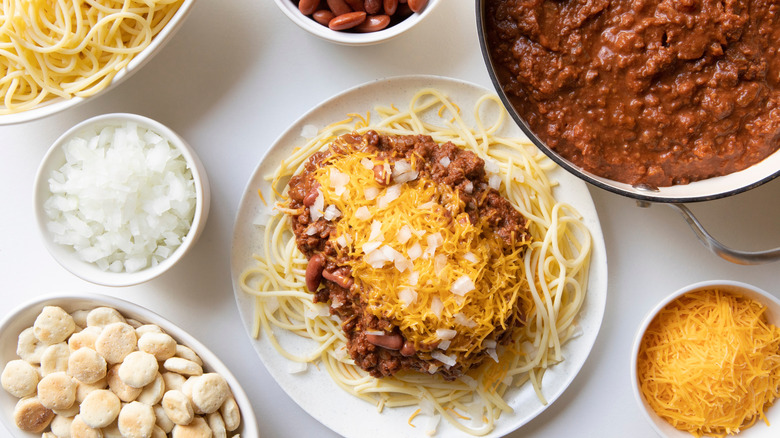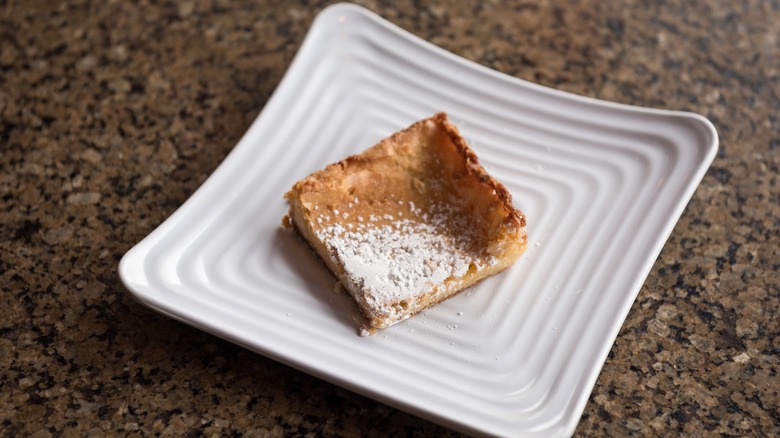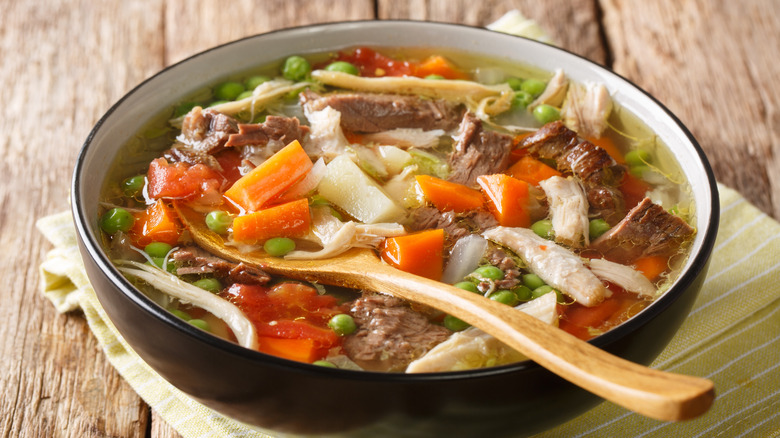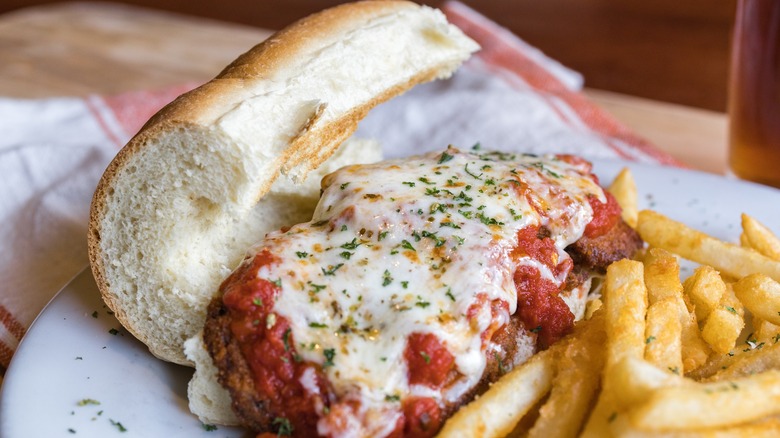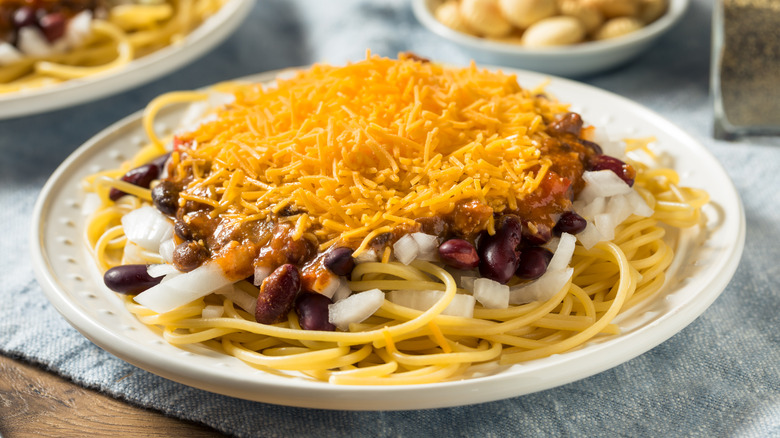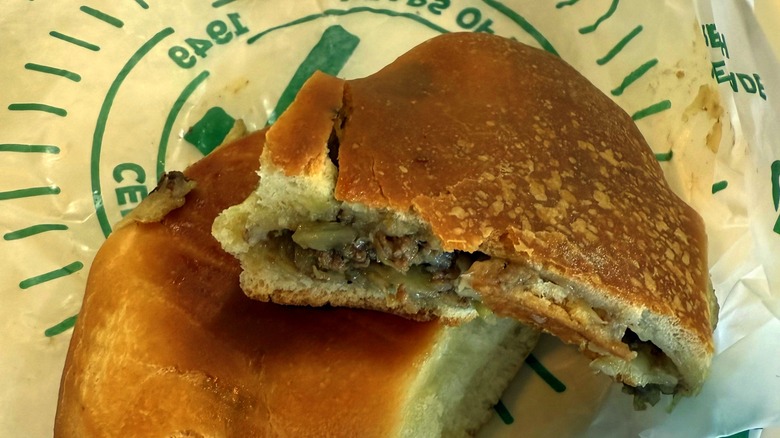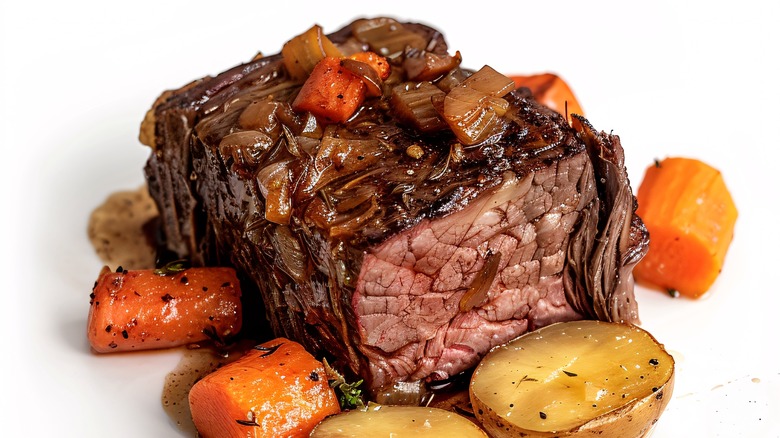Vintage Midwestern US Dishes That Deserve A Comeback
We may receive a commission on purchases made from links.
Vintage dishes have a superpower. One bite can transport us back in time with memories of mom's cooking, family dinners, Thanksgiving feasts, and Christmas celebrations, filling our hearts with yearning for simpler times. In the case of vintage Midwestern dishes, comfort food has long held a place of honor, and the nostalgic lore continues to be stronger than ever.
Dishes like booyah, funeral potatoes, and butter cake may sound quaint or intriguing to some, but for many, the food of the Midwest represents the authentic taste of home. With fans across the country, these recipes are rich in flavor, with many being surprisingly simple to prepare. Though evolving diets and modern trends have pushed some of these classics out of fashion, we say it's time to bring them back as they are worthy of broader appeal. These stalwarts of the Midwestern culinary world deserve their place in the limelight again and should be treasured for their timeless appeal.
The following dishes are sure to delight today's eaters just as they did decades ago, offering both comfort and flavor that modern kitchens can embrace. After all, some traditions are just too good to lose.
Hotdish
The name "hotdish" is a term used widely in the Midwest, specifically in Minnesota. Often referred to as the unofficial state dish, hotdish — which is not the same as casserole — is a mix of simple budget ingredients thrown together and cooked as a simple oven-baked meal. The name itself can evoke a strong sense of nostalgia for many who grew up relishing its many variations.
Though it dates back earlier, the hotdish became popular during World War I, when food rationing was the norm and meat supplies were thin on the ground. Meals like these became a way to stretch this limited availability by adding fillers such as rice and noodles or vegetables and oatmeal to bulk up the dish and feed more mouths. The parallel rise in popularity of canned and frozen foods made it easier to put together a hotdish in no time, and it soon became the reliable family favorite in the Midwest.
Most recipes start with a base of canned cream of mushroom soup and canned vegetables, with meat or fish and potatoes included to add some variety. While similar to a casserole, locals will insist there are several (subtle) differences that only a true Minnesotan would be able to discern. It's traditionally served as a main course, usually making an appearance at family gatherings and church suppers. There are thousands of recipes for this dish, including one favored by Minnesota governor and former vice-presidential nominee Tim Walz.
Chicken à la king
A fashionable dish that was especially popular in the 1970s and '80s, chicken à la king is a creamy comfort meal that's typical of the era's culinary indulgence. One could be forgiven for thinking that this was a recipe fit for a king, but the truth is far more mundane. Legend has it that it was named by its creator, a chef, to impress the owner of the hotel where he was working. However, there are other stories about its origin floating around the internet, so which one is true is anyone's guess.
Whatever its origins, chicken à la king quickly came to epitomize mid-century American fine dining. The dish, with its rich, creamy white sauce laden with chicken and mushrooms, soon became a fixture at many restaurants. The recipes evolved, with tomatoes and bell peppers added for color and flavor, and the more upscale restaurants adding sherry or wine to give it an additional air of sophistication.
Homemade chicken à la king can be served on vol-au-vents, toast, or even over buttered pasta. Its versatility makes it suitable for almost any special occasion or celebration. Although its popularity waned during the latter half of the 1980s, the renewal of interest in comfort foods makes it the right candidate for a comeback.
Funeral potatoes
Also known as the cheesy potato casserole, funeral potatoes are an old-fashioned Midwestern dish that works really well for large gatherings. The name traces back to its frequent appearance at post-funeral lunches. A classic comfort food made with hash browns, the addition of sour cream and cheddar cheese, and crowned with a layer of crispy cornflakes or crushed potato chips makes these spuds a crowd-pleaser in terms of both flavor and texture.
Easy to prepare and scalable to feed large groups, this dish is a practical favorite for potlucks, family reunions, and church suppers alike. Its origins remain uncertain, but it soon became a staple within the Utah-based Latter-Day Saint community, and over time, its popularity spread across the Midwest and beyond.
In today's health-conscious world overflowing with kale salads and Buddha bowls, funeral potatoes might seem out of place. Then again, no green salad can take the place of the satisfaction that comes from a generous serving of these cheesy potatoes. We figure with a few modern substitutes, such as using Greek yogurt instead of sour cream or adding in some fresh herbs or a drizzle of chili oil for a fresher take on the vintage Midwestern recipe, it can once again reclaim its rightful place on dinner tables everywhere.
Gooey butter cake
Originating in St. Louis, legend has it that the gooey butter cake was probably invented around the time of the Great Depression by a bakery located on the south side of the city. As a result of a happy accident, an erring baker substituted butter for either sugar or flour in the recipe, but (thankfully) instead of binning the lot, the resulting oozy, rich slice was served up as is. To everyone's surprise, the response was so good that the bakery was compelled to continue production of the butter cake. Soon, other bakeries got in on the act, and the cake's popularity continued to grow, with the people of St. Louis and Missouri giving it an overwhelming thumbs up.
Today, there are several versions of the gooey butter cake available, with companies like Ann & Allen Baking producing over 70 flavors and distributing these decadent treats all over the country. As more and more people turn towards a simpler, less restrictive way of life and classic American sweets and desserts return to dinner tables around the country, this vintage cake is poised for a well-deserved comeback. Its simple ingredients and straightforward technique make it accessible for home bakers, while its indulgent richness ensures it remains a showstopper for celebrations.
Booyah
A hearty fall stew tradition of the Upper Midwest, the origin of booyah stew is thought to have its roots in Belgium. The stew is traditionally cooked in large kettles over a wood fire and served at community gatherings and church celebrations. The name booyah may be an adaptation of the French word "bouillon," which means "broth" in English, though spellings and recipe variations abound.
Making booyah is usually a lengthy process, with the stew left to simmer for up to two days. While there's no definitive version of booyah, that's part of its charm. Recipes usually include a mix of beef, chicken, and pork, plus a combination of root vegetables, corn, green beans, and tomatoes. Meat bones are often left in while cooking to add an unctuous layer of fatty richness, giving the concoction a depth of flavor that can only be achieved through time and patience.
For many Midwesterners, booyah remains a traditional dish that harkens back to simpler times when fast food didn't exist and meals were cooked by grandma the old-fashioned way. Today, it might seem impractical, not to mention unnecessary, to wait two days to enjoy a meal. But we foresee a future where booyah's revival signals a welcome return to slow, communal traditions and a triumph over quick-fix solutions and speedy, unhealthy meals.
Breakfast wild rice
The state grain of Minnesota is wild rice, a richly flavored seed (wild rice isn't actually rice) that is packed with protein, fiber, and minerals, making it one of the most nutritious whole foods available. A porridge made with wild rice, and sometimes with oats, is quite popular in Minnesota as a breakfast dish. The rice imparts a welcome nutty flavor and chewiness and gives the dish a richness that is further enhanced by a pour of cream and maple syrup to finish things off. Topped with toasted nuts, dried fruit, or even a dash of cinnamon, it's a warm, sustaining breakfast that sticks with you (pun not intended).
There seem to be two reasons why this dish hasn't become more popular. One could be the limited availability of wild rice beyond the regions where it is grown. The other could be the longer cooking time, which makes it an inconvenient choice, especially on rushed days. But in an age when people are rediscovering ancient grains and prioritizing whole foods, wild rice seems poised for its moment of fame.
Hot dago
An Italian-American creation that first appeared in St. Paul in the early 20th century, the hot dago was a classic workingman's meal. Its controversial name — which originates from a slur against Italian and Spanish immigrants – may be one reason this delicious sandwich has remained a hyper-local specialty.
The main ingredient of the hot dago is an Italian sausage patty nestled between slices of bread or a roll and topped with spicy marinara sauce and melted cheese. The cheese used can vary, with some chefs preferring mozzarella and others opting for provolone or blended cheeses. Many versions include flavorful add-ons like pepperoncini, onions, garlic, spices, and more. What all varieties have in common is that they are packed with flavor and are very, very filling. We believe that this Italian-American classic is overdue for a revival and that it's high time more people got a taste of one of Minnesota's most mouthwatering sandwiches.
Cincinnati chili
A dish that elicits extreme reactions, with some extolling its virtues and others trashing it with gusto, Cincinnati chili is the classic story of immigrant ingenuity shaping American culture. According to food historian Dann Woellert's book "The Authentic History of Cincinnati Chili," brothers Tom and John Kiradjieff, who immigrated from Macedonia, created their version of a Mediterranean spiced stew. Their stew was elevated with chili powder, cloves, nutmeg, cinnamon, and other spices to create what would become a classic dish. Since then, it has been adapted in several ways to meet local tastes and serving styles.
Cincinnati chili has become a classic comfort food that can be served in different ways, either alone in a bowl, with spaghetti, or even over a hot dog. Toppings can include grated cheddar cheese, raw minced onions, and beans. The list of ingredients in many of the recipes can raise eyebrows, what with cinnamon being added along with allspice, cloves, and chocolate.
This dish's popularity, however, still remains largely confined to Cincinnati and other areas of Ohio. Outside of the state, it remains largely unknown and unloved, the strong flavors and odors probably working against it. To gain popularity in other regions will take some doing — and possibly some expert PR.
Runzas
Fluffy dinner rolls stuffed with ground beef, onions, and cabbage, runzas are a specialty of Nebraska, though the concept is similar to hand pies found in other cultures. Like the more famous samosas — which originated in Central Asia and the Middle East but are today often associated with Indian cuisine — or empanadas, which are said to stem from Galicia in Spain but are commonly linked to Latin America, they are made by wrapping dough around a savory filling. Runzas are the perfect grab-and-go food and are great served with french fries or onion rings.
The history of the runza can be traced back to German-Russian immigrants in the late 19th century. They adapted Eastern European dumplings to create a handheld sandwich, the bierock. It was made from yeast dough with a savory filling that was ideal for carrying into the fields for a midday meal. The name bierock later evolved to runza in Nebraska, possibly derived from a word for "belly" in the Low German dialect.
Along came Sally Everett in 1949, who trademarked the name and, along with her brother, Alex Brening, opened the first Runza restaurant in Lincoln. Today, there are close to a hundred Runza restaurants spread over Nebraska and a handful of other states. It's clear this handheld sandwich has carved out a firm place in the Cornhusker State's culinary identity. Outside Nebraska and the Great Plains, the snack remains largely unknown — but with its rich cultural backstory and easy-to-carry appeal, it's more than ready for a national revival.
Pot roast
Pot roast exemplifies Sunday suppers as few dishes can. This wholesome, slow-cooked meal has become a staple of Midwestern kitchens over the decades, offering an affordable way to feed large families. Made from inexpensive cuts of beef, such as chuck, pot roast is usually slow-cooked with vegetables and broth over a low flame. It became the ultimate one-pot meal that was both nourishing and satisfying and deeply tied to Midwestern values of thrift and warmth.
The scarcity and deprivation of the Depression and post-war years may be a thing of the past, and in recent decades, pot roast has been overshadowed by flashier trends — but we say it's time to bring it back into favor (with a few 21st-century upgrades). Today, home cooks can turn on their Instant Pots to cook up this flavorful pot roast and modernize this classic with some easy ingredient swaps. A splash of balsamic vinegar or red wine, along with herbs and spices, can add some modern flair to an otherwise staid meal. You can also substitute the usual carrots and potatoes for roasted parsnips, shallots, or pearl onions. Any of these will make a dish worthy of a modern-day dining table. Served with egg noodles or polenta, this traditional dish is now ready for its second act.
St. Louis pizza
A controversial regional pizza that is the subject of much mockery, the St. Louis pizza is a square-cut pie with a major fan following, nonetheless. The crust is an extremely thin affair that is almost like a cracker, and the cheese, a melted blend, is one that not everybody accepts as pizza-worthy. Truth be told, the St. Louis pizza is a different style of pizza, standing apart from its more famous New York and Chicago counterparts. It has its own distinct identity and is unapologetic about it. For this reason alone, we would argue that it deserves to be respected and at least given a chance.
While the unleavened crust is thin and crackery, it is still firm enough to support generous amounts of topping without collapsing. It is an ideal base to share, easy to cut, and the square shape — also known as a party cut – means you can easily pick up a piece and bite into it. This also makes it the ideal food to share at the communal table.
The Provel cheese used is an original St. Louis blend of cheddar, Swiss, and provolone, melting easily to cover every inch of the crust. It stays creamy even when left out until the next day, making it the ideal leftover food. So, let's stop comparing the St. Louis pizza to other styles and enjoy its distinctiveness for its own sake.
